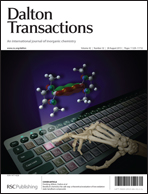The new metalloligand ferrocenylbis(phosphonite), [Fe(C5H4PR2)2 (R = OC6H3(OMe-o)(C3H5-p))], (2), is synthesized by the reaction of bis(dichlorophosphino)ferrocene Fe(C5H4PCl2)2 (1) with 4-allyl-2-methoxyphenol. The reactions of 2 with H2O2 and elemental sulfur or selenium afforded bischalcogenides, [Fe{C5H4P(E)(OC6H3(OMe-o)(C3H5-p))2}2] (3, E = O; 4, E = S; 5, E = Se), in good yield. The bis(phosphonite) reacts with group 6 metal carbonyls and group 10 metal dichloride precursors to produce the chelate complexes [{M(CO)4}Fe{C5H4P(OC6H3(OMe-o)(C3H5-p))2}2}] (6, M = Mo; 7, M = W) and [(MCl2)Fe{C5H4P(OC6H3(OMe-o)(C3H5-p))2}2] (8, M = Pd; 9, M = Pt). The palladium(II) complex [(PdCl2)Fe{C5H4P(OC6H3(OMe-o)(C3H5-p))2}2] (8) is an efficient catalyst for the Suzuki–Miyaura cross-coupling reactions (TON up to 1.5 × 105). The reaction of 2 with one equivalent of [RuCl2(η6-p-cymene)]2 yielded the binuclear complex [{Ru2Cl4(η6-p-cymene)2}Fe{C5H4P(OC6H3(OMe-o)(C3H5-p))2}2] (12) in good yield. Treatment of 2 with copper chloride in a 1 : 1 or 1 : 2 molar ratio resulted in the formation of a binuclear complex, [{(CuCl)Fe{C5H4P(OC6H3(OMe-o)(C3H5-p))2}2}2] (13), whereas a similar reaction of 2 with CuBr and CuI in a 1 : 2 or 1 : 2.5 molar ratio yielded the novel butterfly-like deca-nuclear complexes [Cu5(μ-X)5{Fe{C5H4P(OC6H3(OMe-o)(C3H5-p))2}2}2]2 (14, X = Br; 15, X = I). The reaction of 2 with two equivalents of [AuCl(SMe2)] afforded the digold complex [(AuCl)2Fe{C5H4P(OC6H3(OMe-o)(C3H5-p))2}2] (16), with the ligand exhibiting bridged-bidentate mode of coordination. Additionally, some complexes were studied by cyclic voltammetry. The crystal structures of complexes 8, 9, 12, 15 and 16 were determined using X-ray diffraction studies.
![Graphical abstract: Synthesis, transition metal chemistry and catalytic reactions of ferrocenylbis(phosphonite), [Fe{C5H4P(OC6H3(OMe-o)(C3H5-p))2}2]](/en/Image/Get?imageInfo.ImageType=GA&imageInfo.ImageIdentifier.ManuscriptID=C3DT50995H&imageInfo.ImageIdentifier.Year=2013)

 Please wait while we load your content...
Please wait while we load your content...